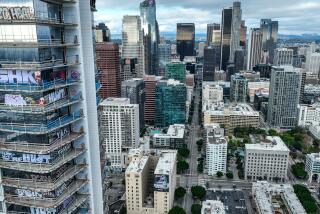Guerrilla Girls Comb Museums to Find Truth in Numbers : Art: Anonymous activists visit LACMA to take an accounting and to shine a spotlight on sexism and racism.
They come bearing bananas and broadsides.
Two chic black-clad women in gorilla masks enter the Los Angeles County Museum of Art, note pads and yellow phallic fruits in hand. Heads turn as they stride purposefully toward the displays of contemporary and modern art from the museum’s permanent collection.
Who are those masked women? , the afternoon museum-goers wonder, as the savvy among them smirk with recognition.
They are the Guerrilla Girls, the anonymous avengers who have been waging clever yet scathing poster campaigns against the art world’s ongoing sexism and racism for a decade now. They call themselves the “conscience of the art world.”
Two of their number--nobody knows who or how many they are, although the group is said to be made up of artists and arts professionals based mostly in New York--were in L.A. during the weekend to promote their new book, “Confessions of the Guerrilla Girls,” just out from HarperCollins. They were also here to count.
Strolling amid the Chagalls, Magrittes and Kandinskys in LACMA’s modern installation, the masked twosome ran a tally.
“That’s nine out of nine WMs in this room,” says Guerrilla Girl Zora Neale Hurston, using the shorthand for “White Males” as she reports to her cohort, Kathe Kollwitz. (The Guerrilla Girls use the names of dead female artists as anonyms and as a nod to their predecessors.)
One floor below, the works of Robert Gober, Christian Boltanski, Edward Ruscha and others set the (testoster)tone. But it’s a Barbara Kruger that says it all: “You Substantiate Our Horror,” the painting reads, as if speaking right to the Guerrillas.
Certainly, they quantify it (although the following numbers may not be precise). For LACMA’s modern art display: 91 male artists (including one Asian), four female. No African Americans. No Latinos.
In the contemporary installation, the score is only slightly better: 50 males (including one Asian, two African Americans, one Latino) and seven women (including two Asians, no African Americans, no Latinas).
Seated at a small patio table in the breezy LACMA courtyard (it apparently gets sweaty underneath those hairy rubber masks), Hurston and Kollwitz ponder their findings.
“Things aren’t as bad as they used to be,” says Kollwitz, aware of the irony of her statement, while noting that the numbers they found at San Francisco Museum of Modern Art were worse.
“The problem is that the art world is set up to condense history to five people and it’s still usually five guys.”
Hurston and Kollwitz also check out a list--provided, unsolicited, by a museum official--of female artists in the LACMA collection broken down by year of acquisition. But the Guerrillas--who regret that there isn’t time to visit MOCA too--aren’t satisfied, particularly given how few nonwhites are named.
“Are you the Guerrilla Girls?” an excited Guerrilla Groupie in hippie-grunge duds asks as she approaches the table. “Great work!”
*
Since the first Guerrilla Girls poster was created--in response to a 1985 exhibition at the Museum of Modern Art in New York--the group has taken aim not only at art consumers but also curators, trustees, critics and even artists themselves. They have also branched out to address not only art world but also social issues.
And they claim some success. “People who review exhibitions are now paying attention to how many (nonwhite/male) people are in shows,” Hurston says. “We take that credit a great deal because we started the counting activity.”
Yet there have been problems with the progress. “When museums around the country tried to increase the number of artists of color they were showing, white women paid the price,” Kollwitz says. “There weren’t fewer white males, there were fewer white women.”
“They’re doing this so that you can grow up and be anything you want,” a middle-aged father coos to the blonde little girl in his arms, who’s plainly terrified of the gorilla masks.
Later, after LACMA, the Guerrilla Girls slip through the hip Saturday night throngs on the Third Street Promenade in Santa Monica on their way to a book signing at Midnight Special.
The crowd of 70-some people is buzzing as they make their entrance. Plopping a bunch of bananas on the podium, they proceed to hold forth with characteristic candor and humor about making the art world accountable.
“Everybody’s responsible,” says Hurston. “You’ve got to be vigilant.”
Of course, they admit that being an activist is a tough gig.
“It’s not easy,” Hurston says. “We don’t get paid and this doesn’t help our careers.”
But, Kollwitz adds, “it’s a fun thing to do with your anger.”
More to Read
The biggest entertainment stories
Get our big stories about Hollywood, film, television, music, arts, culture and more right in your inbox as soon as they publish.
You may occasionally receive promotional content from the Los Angeles Times.










